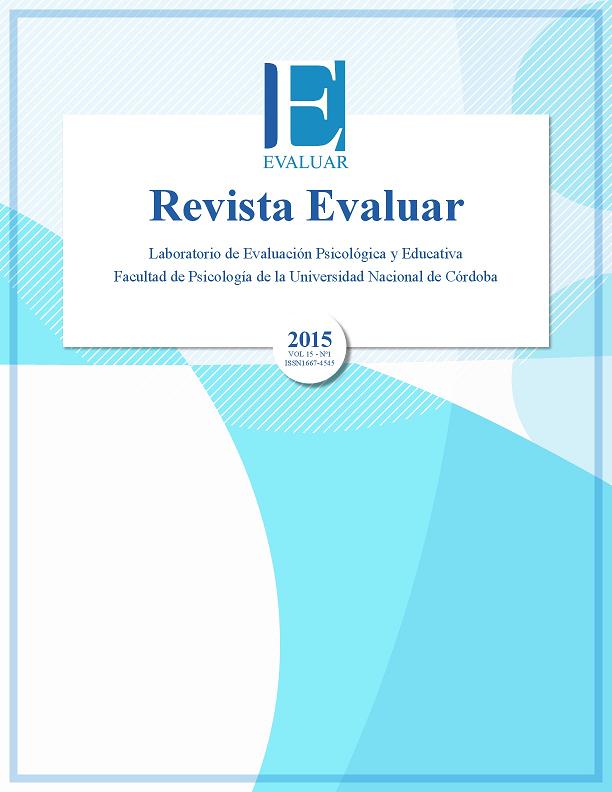Matrices progresivas de Raven: punto de corte para preescolares 4 - 6 años
DOI:
https://doi.org/10.35670/1667-4545.v15.n1.14911Keywords:
Raven, intelligent coefficient, preschool, intelligenceAbstract
A descriptive study was conducted - correlational in several schools in the provinces of Cienfuegos and Matanzasto determine a cut-off of the preschool child 4 to 6 years. Standardization sample (N1) and validation sample (N2): two
samples were used. N1 was composed of 406 children: 108 4 years 102 5 years 196 6 years. N2 was composed of 130
children: 30 to 4 years, 50 with 5 years and 50 to 6 years. The receiver -operator curve method was used to select the cut.
The validity of the test was obtained through correlation with two reasoning tasks (Similarities - Differences and numerical
operations). The Cronbach's alpha indicated the reliability of the test. The test presents suitable for application in presch ool
psychometric properties. The cutoffs selected showed appropriate values to detect intellectual risk in preschool.
Downloads
References
Barkl, S., Porter, A., & Ginns, P. (2012). Cognitive training for children: effects on inductive reasoning, deductive reasoning and mathematics achievement in an Australian school setting. Psychology in the Schools, 49(9), 828–842.
Carretero-Dios, H., & Pérez, C. (2005). Normas para el desarrollo y revisión de estudios instrumentales. International Journal of Clinical and Health Psychology, 5, 521-551.
Desco, M., Navas-Sanchez, F. J., Sanchez-González, J., Reig, S., Robles, O., Franco, C., ..., & Arango, C. (2011). Mathematically gifted adolescents use more extensive and more bilateral areas of the fronto-parietal network than controls during executive functioning and fluid reasoning tasks. Neuroimage, 57(1), 281-92.
Fernández Liporace, M., Ongarato, P., Saavedra, E., & Martina Casullo, M. (2004). El Test de Matrices Progresivas, Escala General: un análisis psicométrico. Evaluar, 4, 50-69.
Hazbún, J., Forno, H., Ivanovic, D., Durán, M. C., Castro, C., & Ivanovic, R. (2003). Estudio de la capacidad intelectual (Test de matrices progresivas de Raven) en escolares chilenos de 5 a 18 años.: I. Antecedentes generales, normas y recomendaciones. Iberpsicología: Revista Electrónica de la Federación Española de Asociaciones de Psicología, 8(1), 1579-4113.
Kamphaus, R. W., & Reynolds, C. R. (2003). Reynolds intellectual screening test. Odessa, FL: PAR.
Ledesma, R., Molina, G., & Valero, P. (2002). Análisis de consistencia interna mediante Alfa de Cronbach: un paquete basado en gráficos dinámicos. Psico-USF. 7(2), 143-152.
Leeuwen, M., Van den Berg, S., Hoekstra, R. A., & Boomsma, D. (2007). Endophenotypes for intelligence in children and adolescents. Intelligence, 35, 369-380.
Luo, D., Thompson, L. A., & Detterman, D. K. (2006). The criterion validity of tasks of basic cognitive processes. Intelligence, 34, 79-120.
Manga,D., & Ramos, F. (2006). Luria Inicial: Evaluación neuropsicológica en la edad preescolar. Manual. Madrid: TEA Ediciones.
Manrique Millones, D., Flores-Mendoza, C., & Millones Rivalles, R. (2015). Intelligence in Peru: Students' results in Raven and its relationship to SES. Intelligence, 51, 71–78.
Muñiz, J. (2004). La validación de los tests. Metodología de las Ciencias del Comportamiento, 5, 121-141.
Primi, R., Ferrão, M. E., & Almeida, L. (2010). Fluid intelligence as a predictor of learning: A longitudinal multilevel approach applied to math. Learning and Individual Differences, 20, 446–451.
Raven, J. C. (2004). Test de matrices progresivas. Escala coloreada. Cuaderno de Matrices / Series A, AB y B. México: Paidós.
Resnick, R. J., & Entin, A. D. (1971). Is an abbreviated form of the WISC valid for Afro-Americans? Journal of Consulting and Clinical Psychology, 36, 97-99.
Ritchie S. J., Bates, T. C., & Plomin, R. (2015). Does Learning to Read Improve Intelligence? A Longitudinal Multivariate Analysis in Identical Twins from Age 7 to 16. Child Development, 86(1), 23–36.
Schlagenhauf, F., Rapp, M. A., Huys, Q. J., Beck, A., Wüstenberg, T., Deserno, L., ..., & Heinz, A.(2013). Ventral striatal prediction error signaling is associated with dopamine synthesis capacity and fluid intelligence. Human Brain Mapping, 34(6): 1490–1499.
Swets, J. A. (1988). Measuring the accuracy of diagnostic systems. Science, 240, 1285-1293.
Tong, F., & Fu, T. (2013). Meta-Analysis of Fluid Intelligence Tests of Children from the Chinese Mainland with Learning Difficulties. PLoS ONE, 8(11), e78311. doi: 10.1371/journal.pone.0078311
Van Bergen, E., de Jong, P. F., Maassen, B., Krikhaar, E., Plakas, A., & Van der Leij, A. (2013). IQ of Four-Year-Olds whogo onto Develop Dyslexia. Journal of Learning Disabilities, 14,1–10.
Yuan, Z., Qin, W., Wang, D., Jiang, T., Zhang, Y., &Yu, C. (2012). The salience network contributes to an individual's fluid reasoning capacity. Behavioural Brain Research, 229(2), 384-90.
Zhao, X., Wang, Y. X., Liu, D. W., & Zhou, R. L. (2011). Effect of updating training on fluid intelligence in children. Chinese Science Bulletin/ Psychology, 56(21), 2202-2205.
Downloads
Published
How to Cite
Issue
Section
License
Copyright (c) 2015 Yaser Ramírez Benítez, Rodneys Mauricio Jiménez-Morales, Miriela Díaz Bringas

This work is licensed under a Creative Commons Attribution 4.0 International License.
Revista Evaluar aplica la Licencia Internacional de Atribuciones Comunes Creativas (Creative Commons Attribution License, CCAL). Bajo esta licencia, los autores retienen la propiedad de copyright de los artículos pero permiten que, sin que medie permiso de autor o editor, cualquier persona descargue y distribuya los artículos publicados en Evaluar. La única condición es que siempre y en todos los casos se cite a los autores y a la fuente original de publicación (i.e. Evaluar). El envío de artículos a Evaluar y la lectura de los mismos es totalmente gratuito.




_(3).jpg)



.jpg)



